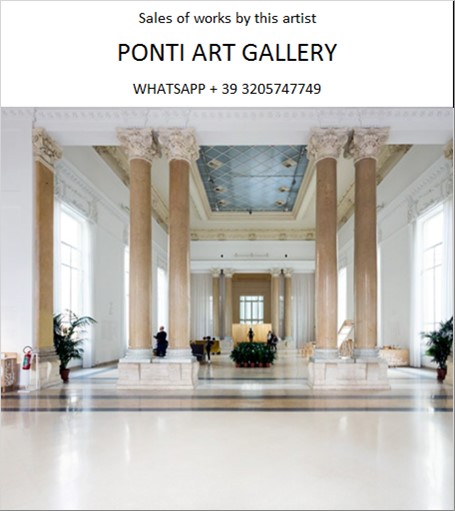Ponti Art Gallery is interested in buying and selling works
of art by this artist.

Gerhard Richter Biography
Gerhard Richter is a German visual artist renowned for his significant contributions to post-war art, with a career that has spanned nearly six decades. Born on February 9, 1932, in Dresden, Germany, Richter's early life was set against the backdrop of the Third Reich and the subsequent political landscape of East Germany. His childhood was marked by the tumultuous events of World War II and the rise of the German Democratic Republic (GDR), experiences that would later influence his diverse body of work.
Richter's family life was relatively ordinary for the time. His father, Horst, was a teacher, and his mother, Hildegard, was a bookseller with a passion for literature and music. The family moved from Dresden to the town of Reichenau, now Bogatynia in Poland, and later to the village of Waltersdorf. Despite the challenges of the era, Richter's parents managed to provide a structured and culturally rich environment for their children.
During his formative years, Richter was conscripted into the Pimpfen, a preparatory organization for the Hitler Youth, reflecting the pervasive influence of the Nazi regime on everyday life. However, his family was not politically active, and his father's reluctant membership in the National Socialist Party was a professional necessity rather than an ideological choice.
After the war, Richter's father was detained as a prisoner of war and struggled to reintegrate into society upon his return. The family faced economic hardship, and Richter's artistic talents began to emerge during this period of adversity. He received a simple plate camera as a Christmas gift from his mother, which sparked his lifelong interest in photography.
Richter's formal art education began at the Dresden Art Academy, where he studied from 1951 to 1956. There, he was trained in Socialist Realism, the state-mandated style that promoted communist values. Despite his success as a Social Realist painter, Richter became disillusioned with the limitations of the style. His exposure to Western art during permitted travels to West Germany opened his eyes to the avant-garde movements of the time, such as Abstract Expressionism and gestural abstraction.
In 1961, shortly before the construction of the Berlin Wall, Richter made a pivotal decision to leave East Germany for Düsseldorf in the West. This move marked the beginning of his engagement with the vibrant art scene of post-war West Germany. He attended the Kunstakademie Düsseldorf, where he met influential artists like Sigmar Polke and Blinky Palermo. It was during this time that Richter began experimenting with photo-based paintings, drawing from personal photographs, newspapers, and magazines.
Richter's oeuvre is characterized by its stylistic diversity, oscillating between photorealistic paintings, abstract works, and glass pieces. He has explored themes ranging from the banal to the historical, often blurring the lines between reality and representation. His "photo paintings" from the early 1960s, such as "Tisch" (Table), exemplify his technique of using photographs as a basis for his paintings, which he would then disrupt with gestural brushwork.
Throughout his career, Richter has remained skeptical of ideological and stylistic dogmatism. His work often reflects a critical engagement with the history of painting and the role of the artist in society. He has produced landscapes, cityscapes, portraits, and color charts, each revealing his nuanced approach to the medium. His "Baader-Meinhof" series, for instance, delves into the controversial subject matter of the Red Army Faction, demonstrating his willingness to confront difficult historical narratives.
Richter's abstract works, which he began titling "Abstract Painting" in 1976, showcase his experimental approach to form and color. He employs a range of techniques, including the use of a squeegee to scrape layers of paint across the canvas, creating complex and textured surfaces. These paintings invite viewers to engage with the materiality of paint and the process of artistic creation.
Richter's impact on contemporary art is profound, with his works commanding high prices at auction and being featured in major exhibitions worldwide. He has received numerous accolades, including the Praemium Imperiale and the Golden Lion at the Venice Biennale. Despite his commercial success, Richter maintains a critical distance from the art market, focusing instead on the intrinsic value of artistic practice.
Today, Richter is celebrated as one of the most important living artists, with a legacy that continues to influence generations of artists. His commitment to exploring the possibilities of painting, coupled with his critical reflection on the medium's history, has solidified his place in the canon of contemporary art.
Gerhard Richter Quotes and
Sales of Works
Ponti Art Gallery selects and deals with paintings by the
artist. Upon request, we provide free estimates and
evaluations, communicate prices, quotations, and current
market values.
If you are interested in BUYING or SELLING works by the
artist, contact us immediately.
If you wish to sell or receive an evaluation of the
works:
Send us a frontal photo of the painting, one of the back,
and one of the signature. Also, indicate the dimensions of
the work. Inform us about the purchase origin of the work
and any kind of available documentation (purchase
receipts, certificates of authenticity, publications). One
of our operators will respond to you on the same day. We
guarantee maximum confidentiality and extreme
professionalism.
If you wish to purchase works by the painter: Contact us
and let us know your request. We will inform you about the
available works. We also offer the possibility to
subscribe to our NEWSLETTER, through which you will be
informed at the beginning of each month about the latest
acquisitions of the art gallery.
You can send us pictures of the work:
